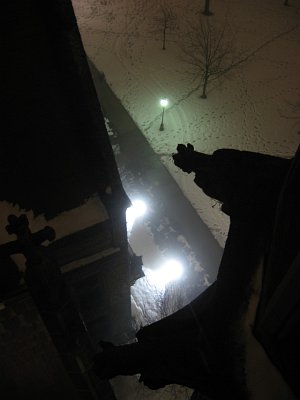The new lights have created extensive light pollution in the local sky, a phenomenon that occurs when light scatters off air molecules. As a result, distant stars and galaxies disappear in the uniform glow of the overlit sky. Dean Armstrong, a longtime RAS member and University staff member, recalls a time when the stars were more easily visible from Ryerson.
“We used to show galaxies as part of a standard observation,” he said. “We don’t do it anymore. Either people can’t see them, or they’re just unimpressive.”
Located immediately below the Ryerson telescope, the new lights have brought the hurt home. A new light installed last week shines directly on the dome topping the telescope, and many others shine directly into the sky surrounding it.
Claims that these lights are shielded and only hit the first 25 feet of the facade are false. Here's a few images:

Do these lights only hit the first floor? No. View from the six-story roof.
The inverse view, lighting up the turret.
Blinding glare around the corner of Ryerson
Coverage of "shielded" light extends to nearly the zenith.
This light directly hits the dome and is much brighter in person.
Additional images at http://www.lib.uchicago.edu/~dean/lights/
5 comments:
I'm not sure how lighting the side of a building upward from the ground improves safety.... Of course, every building in Vegas is lit that way to show off the, ahem, architecture.
Have you considered making your own shields and holding a guerrilla installation party some night? Then you could point to that and say, "Hey, we're not admitting that we did it, but isn't this better?"
My hometown of Vegas certainly isn't the model of light control, for sure. At least you can jump out of town fairly quickly and see a relatively dark sky.
Hmm, an idea.
Could I borrow some of those for my occasional "Bike Racks of Hyde Park" series?
And I'm all for the guerrilla shielding. I also have to wonder if anyone would even notice.
Post a Comment